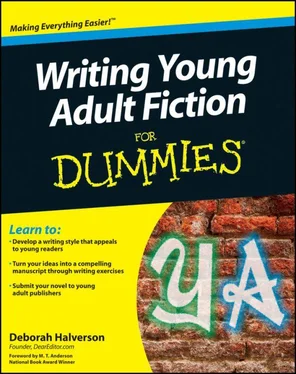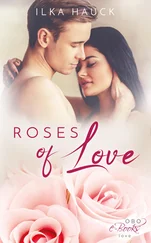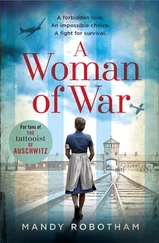They also learn the rules of story. They learn how some novels reflect their lives and some novels take place on other worlds. They learn a grammar of stories — how sometimes things move quickly and sometimes things move slowly, how characters are different from and similar to real people, how plot twists happen and what makes a joke funny. Books for young people, after all, train us all to appreciate literature for adults — as well as to make some sense of our own teeming, crazy world.
So as you think about writing stories for young adults, remember that your audience will greet you ecstatically — but they’ll also have high expectations. They will be fervent in their reactions, positive and negative. (Few adults, on finding a book boring, will throw it under the bed, start kicking the floor, and turn purple.) It’s an amazing journey to take with a young person. I hope you enjoy it — and that you someday find young readers lost in your book, sunk in your world, whisked away from their bedrooms, their kitchens, their buses, exploring a place you made. That, after all, is one of the greatest gifts you can give them — and yourself.
— M. T. Anderson National Book Award Winner, National Book Award Finalist, L.A. Times Book Prize Winner, and two-time Michael L. Printz Honor Book Author
With young adult book sales rising and bestselling authors exploding onto the scene with multibook contracts and movie deals, aspiring writers of young adult (YA) fiction are more numerous than ever. But the appeal of writing YA fiction is more than creating high-profile bestsellers. It’s writing for kids. It’s expanding their vocabulary and their imaginations. It’s forming reading habits for life. And it’s adding to the impressive body of young adult literature, with its rich narrative voices, satisfying story arcs, intriguing concepts, natural and revealing dialogue, and robust characterizations. Young adult fiction isn’t just for kids anymore; it has heft for grown-ups as well.
Your path to writing YA fiction likely began with your own passion as a young reader, so you know firsthand the joy kids find in books. Now you’re going to create that for others. You’ve chosen a fulfilling mission. The realm you’re entering — the children’s book world — is an amazing community of writers, editors, agents, librarians, teachers, supporters, and champions of young readers. And then there are the readers themselves. You’d be hard-pressed to find a more sensitive, loyal, and responsive audience.
Young adult literature is a moving target as it transforms with each new generation of readers, but some things don’t change: Young readers always want a great read. They want books in which they can see themselves and learn about the world and their place in it, all in ways that enlighten and entertain them. Your job is to meet those expectations. That’s not as simple as it sounds, because you face challenges that writers for adult fiction don’t: You need to talk to teens, to talk like teens, and, sometimes, to talk as if you were a teen yourself. That takes special craft skills and an understanding of your unique audience — the way they think, their interests, their fears, and their dreams.
This book helps you understand that audience so you can work your craft accordingly. I also explain how to operate in the very particular young adult fiction marketplace, because when all is said and done, you’re entering a business with risks, rewards, and rejection. I explain how to think like a kid but strategize your novel and your career like an adult. Welcome behind the scenes of young adult fiction!
My goal in writing this book is to provide you with the tools you need to become a published author of young adult fiction. To that end, I serve up a full plate of writing techniques, along with insights and tips to apply in all phases of crafting your young adult novel. I want to help you get and stay inspired, understand the ins and out of the YA publishing world, avoid common mistakes in trying to reach young readers, submit your manuscript to editors and agents with confidence, and move boldly into the realm of self-promotion. Above all, I hope to guide you in developing a voice and style that appeals to young readers and that is wholly, comfortably yours.
Writing is an abstract endeavor, and the way to make it tangible is to offer examples. So I’ve filled this book with examples. Tons of them. Exercises, too, so you can apply the skills at hand directly to your project. Working through the exercises chapter by chapter can take your fiction from idea to final manuscript. Along the way, I cover the fine points of writing craft in a comprehensive and how-to manner to help you meet readers’ needs… and your own. Where step-by-steps are appropriate, I’ve stepped. Where checklists provide focus, I’ve checked. Where do’s-and-don’ts drive things home, I’ve done. But know that there’s no such thing as a recipe for the Great American YA Novel. Too much depends on how each writer blends the ingredients together. But there are ingredients, and I give those to you here. The bewitching brew you concoct with them is up to you.
Don’t feel you have to read this book from cover to cover. You can skip around if that suits you, picking out topics as your needs dictate at any given time. This book is modular, meaning that even if you start in Chapter 12, the information still makes sense. However, if you prefer to work your way from idea to final bound book, I’ve organized the information so you can start at Chapter 1 and read straight through to the end.
Conventions Used in This Book
I use the following conventions in this book:
 Technical writing and publishing terms appear in italics and are followed by easy-to-understand definitions.
Technical writing and publishing terms appear in italics and are followed by easy-to-understand definitions.
 Web addresses appear in monotype.
Web addresses appear in monotype.
 I vary pronoun gender throughout the book, although you may find more she ’s than he ’s. The ranks of children’s book publishing are abundant with women, as is the readership, so if I do lean, I’m sure it’s toward the feminine.
I vary pronoun gender throughout the book, although you may find more she ’s than he ’s. The ranks of children’s book publishing are abundant with women, as is the readership, so if I do lean, I’m sure it’s toward the feminine.
 I use the term young adult fiction as the world at large does — as a comprehensive label for two distinct publishing categories: middle grade fiction (or simply MG) for ages 9 through 14 and young adult fiction (YA, also called teen fiction ) for ages 12 through 17. Within the children’s book industry, people frequently distinguish between MGs and YAs. When making the distinction in this book is necessary, I do so. But know that all the craft, submission, and marketing information work for both MG and YA fiction because the storytelling techniques are essentially the same and the same publishing players handle both categories.
I use the term young adult fiction as the world at large does — as a comprehensive label for two distinct publishing categories: middle grade fiction (or simply MG) for ages 9 through 14 and young adult fiction (YA, also called teen fiction ) for ages 12 through 17. Within the children’s book industry, people frequently distinguish between MGs and YAs. When making the distinction in this book is necessary, I do so. But know that all the craft, submission, and marketing information work for both MG and YA fiction because the storytelling techniques are essentially the same and the same publishing players handle both categories.
 I use sidebars throughout the book to share my teaching podium with award-winning and bestselling young adult novelists. The material in these gray boxes, written by the guest authors, provides insight into how successful authors wield the skills you build in this book. At the end of each sidebar, I list some of the author’s books. The best way to find out how to write for young adults is to read exemplary YA novels — start with these.
I use sidebars throughout the book to share my teaching podium with award-winning and bestselling young adult novelists. The material in these gray boxes, written by the guest authors, provides insight into how successful authors wield the skills you build in this book. At the end of each sidebar, I list some of the author’s books. The best way to find out how to write for young adults is to read exemplary YA novels — start with these.
You can skip parts of this book altogether if you want to. Information that accompanies a Technical Stuff icon offers extra insight into the process and business of YA fiction, but it’s not crucial reading. The same goes for the gray-shaded sidebar boxes that pepper the chapters. That extra material is meant to fill out your knowledge of the industry and offer you examples of how pros do what I’m explaining how to do, but you won’t sabotage your career by skipping the sidebars.
Читать дальше
Конец ознакомительного отрывка
Купить книгу

 Technical writing and publishing terms appear in italics and are followed by easy-to-understand definitions.
Technical writing and publishing terms appear in italics and are followed by easy-to-understand definitions.










